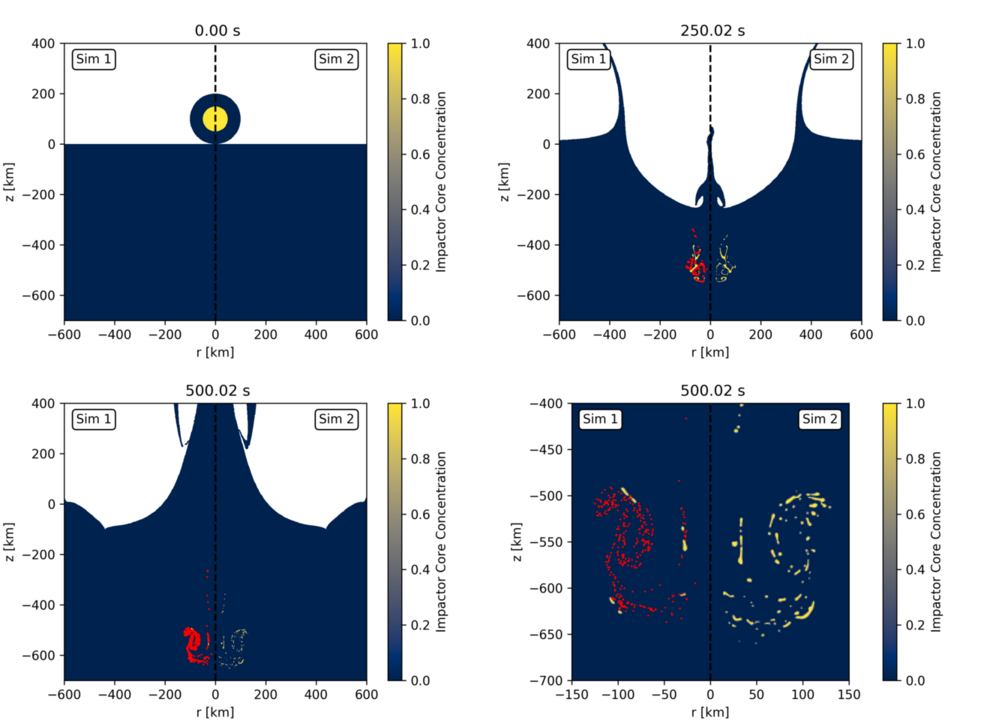- 1Museum für Naturkunde Berlin, Germany (randolph.roehlen@mfn.berlin)
- 2Freie Universität Berlin, Institute for Geological Science, Germany
- 3Institut für Geophysik, Westfälische Wilhelms-Universität Münster, Germany
Introduction: During the late accretion phase, large differentiated bodies impacted the Earth. The material from these impactors, especially from their cores, could have altered the composition of Earth’s mantle and might offer an explanation [1] for the measured high concentrations of highly siderophile elements (HSE) in Earth’s contemporary mantle [2]. Since the planet was most likely covered by a deep magma ocean during this period due to giant collisions like the moon forming impact [3], a better understanding of impacts into these is essential. Especially important is the fragmentation of the impactor core, because a more significant fragmentation would allow better mixing with the surrounding mantle material. Different experimental and numerical approaches have been used to analyze this in the past [4,5]. Following up on this work we improved the fragmentation process in the Eulerian shock physics code iSALE to analyze the effect of different model parameters like impactor velocity, radius and magma ocean depth.
Methods: We use the grid-based Eulerian shock physics code iSALE-2D [6,7] to simulate impacts of differentiated bodies into a magma ocean. iSALE is optimized accurately reproduce large scale features of the impact, such as the resulting crater morphology. Behavior on smaller scales, however, like the detailed fragmentation of impactor material, is not sufficiently resolved. To change this, we developed and implemented a new method that allows for a more accurate simulation of the fragmentation process even on scales close to the grid cell size. The idea of the method is to determine when the size of a fragment as a whole or in part approaches the resolution limit and in such a case use additional petrophysical criteria to determine if fragmentation occurs. In case the criterion is fulfilled, the material is removed from the grid and replaced by a numerical particle representing the fragment in the course of the subsequent material flow.
Our simulation setup consists of a differentiated impactor hitting a magma ocean. The radius of the impactor is on the order of hundreds of kilometers and was varied in different simulations. The velocity ranges between 5 and 20 km/s and different possible depths of the magma ocean relative to the impactor size are explored as well.
Results: In figure 1 we compare simulation results at different time steps with and without the new method. It is visible that the impactor core fragments significantly in both cases for the shown setup. The relative position of these fragments are comparable as well.

Figure 1: Simulations with (Sim 1) and without (Sim 2) the new method at different time steps for a radius of 100 km at a velocity of 11.5 km/s. The impactor core is shown in yellow and the particles used in the new method in red.
The resulting fragment size frequency distribution however is very different, as seen in figure 2. The new method shows significantly finer fragmentation, which is in line with the tendency of regular iSALE to artificially clump material together near the resolution limit resulting in artificially too big fragments.
Figure 2: Cumulative size frequency distribution of the number of impactor core fragments for the simulations shown in figure 1.
The preliminary results generally indicate significant fragmentation of the impactor core, allowing for mixing of the core material with the surrounding mantle. They also show that a higher impact velocity corresponds to stronger disruption, resulting in smaller average fragment sizes. Increasing the impactor radius leads to larger fragment sizes. The effect of the magma ocean depth on the fragmentation is currently being studied.
Acknowledgments: We gratefully acknowledge the developers of iSALE-2D, including Gareth Collins, Kai Wünnemann, Dirk Elbeshausen, Tom Davison, Boris Ivanov and Jay Melosh. This work was funded by the Deutsche Forschungsgemeinschaft (SFB-TRR170, subproject C2 and C4).
References: [1] Wood B. J. et al. (2006) Nature 441:825-833. [2] Walker R. J. (2009) Geochemistry 69:101-125. [3] Tonks W. B. et al. (1993) Journal of Geophysical Research: Planets 98:5319-5333. [4] Daguen R. et al. (2014) Earth and Planetary Science Letters 391:274-287. [5] Kendall J. D. et al. (2016) Earth and Planetary Science Letters 448:24-33. [6] Collins. G. S. et al. (2004) Meteoritics & Planetary Science 39:217-231. [7] Wünnemann K. et al. (2006) Icarus 180:514-527.
How to cite: Röhlen, R., Wünnemann, K., Allibert, L., Manske, L., Maas, C., and Hansen, U.: Shattered Cores? Fragmentation of Asteroid Cores During Impact Into a Magma Ocean., Europlanet Science Congress 2022, Granada, Spain, 18–23 Sep 2022, EPSC2022-1069, https://doi.org/10.5194/epsc2022-1069, 2022.

